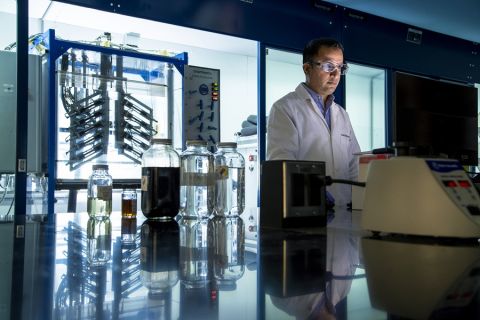Jaxon Caines, technology reporter, Hart Energy: Welcome to Hart Energy's Tech Trends. I'm your host, Jaxon Caines and today we're going to be talking about a slew of new technology, from electrification to AI-assisted seismic interpretation, to what makes artificial intelligence tick.
Axis' EPIC RIG
JC: As the energy industry continues its march into sustainable operations, companies are intensifying their focus on electrifying their solutions. One of the newest examples is Axis Energy’s EPIC RIG.
Last month [March 2024], Axis launched its EPIC RIG, which is a fully electric well service rig.
The rig, which was deployed by Occidental, can run completely on grid power, which reduces emissions and increases fuel flexibility.
It also comes equipped with a built-in programmable logic controller system that works with the Axis CORE platform to give the rig operator precision control and enable automated safeguards that potentially reduce human error.
The EPIC RIG’s variable frequency drive can connect to the public power grid through a transformer, enabling operators to leverage renewable energy sources, eliminate emissions at the well site and save on fuel costs.
On top of that, the EPIC RIG can use a range of diesel alternatives, making it "adaptable" to remote locations and various conditions in the field.
In addition to the rig currently under contract with Occidental, Axis is developing two more rigs that it plans to launch later this year.
Seismic interpretation and collaboration
Transitioning to seismic technologies, a new AI collaboration between Chevron and Eliis will reduce the time needed for advanced seismic interpretation by orders of magnitude.
Announced in late March, the collaboration will combine Chevron’s AI models for automated fault detection with Eliis’ methods for advanced seismic interpretation.
According to Eliis, the technology will enable large-scale geological models to be built with unprecedented detail and accuracy while allowing Chevron to integrate its AI tech into the geoscientific interpretation platform known as PaleoScan.
According to François Lafferrière, chief revenue officer of Eliis, the collaboration has the potential to pave the way for a complete automated workflow from seismic to simulation.
Eliis said it views AI as an enabling technology that must be integrated into the scientific workflow while still allowing geoscientists to remain in control throughout the interpretive process.
AI and chips
Continuing our dive into technology, these days, it seems like if you’re talking about technology, you’re talking about AI. As much of a buzzword it might be, it’s still an incredibly powerful tech that has the potential to transform the world in ways we cannot even anticipate - think back to the dawn of the internet and how ubiquitous it is in daily life.
But the things that make AI work - aside from sophisticated algorithms and large language models - are energy and chips.
AI and generative AI are notoriously energy hungry, Gregory C. Allen of the Center for Strategic and International Studies observed during a session at CERAWeek by S&P Global.
AI is expected to drive a major increase in data center demand for energy, with a projection that energy needs for data centers will double every two years.
Rice University vice president for research Ramamoorthy Ramesh, said, “The problem with exponentials is you don't feel it until it hits you.”
That means if current data center demand for energy is 6%, that doubles to 12% in two years, and 24% two years later.
As Ramesh put it, “That’s scary.”
But what really worries Allen is the fact that Taiwan produces roughly 90% of the most advanced chips in the world. Located on the Ring of Fire, Taiwan recently suffered an earthquake, although at least one leading chip maker has reported operations were unaffected.
Allen said, “Taiwan is an absolute linchpin in the global semiconductor industry for the most advanced semiconductor chips,” including those made by Nvidia and those that go into iPhones.
And the manufacturing process that packs a hundred billion transistors into a tiny space is so sensitive the construction of a train a kilometer away from the assembly plant de-calibrated the machines.
The Biden administration’s export controls restrict sale to China of AI computer chips and the equipment and materials used to make such chips, has Allen worried about the possibility of war over Taiwan leading to a shortage in chip manufacturing.
Allen said, “It really hurts when you don't have enough semiconductors the same way it really hurts when you don't have enough oil.”
Stena Drilling upgrading its drillship
For our last bit of news for this edition of Tech Trends, Stena Drilling announced late March that they will begin installing equipment needed to upgrade the seventh-generation Stena Evolution for 20,000 psi operations.
The Stena Evolution drillship is capable of operating in water depths up to 12,000 feet and drilling depths up to 40,000 feet.
At one point drilling in 15,000 psi conditions posed a lot of challenges, and 20,000 psi operations take those challenges to the next level.
Stena Drilling, together with Shell and NOV will start the installation of the 20,000 psi subsea blow-out preventer and other key equipment in 2026. When the new 20,000 psi equipment package is installed, the Stena Evolution will be able to carry out completion operations in the Shell-operated deepwater Sparta Field in the U.S. Gulf of Mexico.
The Sparta project centers around a 90,000 boe/d production semisubmersible that is expected to go online in 2028.
JC: Well folks, that’s this month’s Tech Trends with me, Jaxon Caines. Check back next month to watch us drill into the tech that fuels the oil patch at hartenergy.com/EP.
Recommended Reading
Defeating the ‘Four Horsemen’ of Flow Assurance
2024-04-18 - Service companies combine processes and techniques to mitigate the impact of paraffin, asphaltenes, hydrates and scale on production—and keep the cash flowing.
AVEVA: Immersive Tech, Augmented Reality and What’s New in the Cloud
2024-04-15 - Rob McGreevy, AVEVA’s chief product officer, talks about technology advancements that give employees on the job training without any of the risks.
Lift-off: How AI is Boosting Field and Employee Productivity
2024-04-12 - From data extraction to well optimization, the oil and gas industry embraces AI.
AI Poised to Break Out of its Oilfield Niche
2024-04-11 - At the AI in Oil & Gas Conference in Houston, experts talked up the benefits artificial intelligence can provide to the downstream, midstream and upstream sectors, while assuring the audience humans will still run the show.





